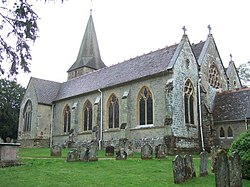Bramshott
| Bramshott | |
| Hampshire | |
|---|---|
 Church of St Mary the Virgin | |
| Location | |
| Grid reference: | SU842329 |
| Location: | 51°5’21"N, 0°47’54"W |
| Data | |
| Post town: | Liphook |
| Postcode: | GU30 |
| Local Government | |
| Council: | East Hampshire |
| Parliamentary constituency: |
East Hampshire |
Bramshott is a village with mediæval origins in the east of Hampshire, a mile north of Liphook and close to the borders of Surrey and Sussex. The Surrey border lies to the east, beyond Bramshott Common, while the bounds of Sussex lie to the south and east of Liphook, but also in a finger reaching up to the west to tickle the western edge of the parish, to encompass such hamlets as Holly Hills and Griggs Green.
The nearest railway station is at Liphook, a mile and a half south of the village.
History
The first evidence for the hamlet of Bramshott is the record of Matthew as its first Rector in 1225 and the early 13th century church. The parish evolved from the mediæval manors of Brembreste (Bramshott today), Lidessete (Ludshott), Ciltelelei (Chiltlee), the royal forest of Woolmer and fragments of two other manors.
Bramshott Manor is described in the Domesday Book as held by Edward of Salisbury from the king with two freemen, thirteen tenants (of restricted freedom) and two mills.[1] Ludshott Manor, lying to the north of Bramshott Manor, is recorded with ten households and a mill.[2] Chiltlee Manor lay to the south of Bramshott Manor and was recorded as being held by the king, with four tenants and land for two ploughs, worth fifty three shillings.[3] These manors lay on the edge of the royal forest of Woolmer, with the origins of Liphook perhaps built as smallholdings to serve huntsmen.
The village grew until the 14th century but was checked by the Black Death. It seems some people escaped from the manors to Liphook to evade taxes of the Lord. Since the 16th century development of Bramshott has been intertwined with that of Liphook.
Parish church
St Mary's Church holds the graves of 318 Canadian soldiers stationed at nearby Bramshott Camp during the First World War, including many victims of the influenza pandemic of 1918-20.
Part of the ancient parish of Bramshott used to be in the county of Sussex, comprising an irregularly shaped protrusion of that county's territory containing Holly Hills and Griggs Green. This reached as far north as the lake at Canforth Park Farm.[4] In addition Bramshott had a small enclave within Sussex, comprising Croft House Farm near Folly Mere.
Environment
Bramshott Chase is an area of National Trust woodland adjacent to the London-Portsmouth Road popular for walking.[5]
See also
Outside links
| ("Wikimedia Commons" has material about Bramshott) |
- Anglican Churches of St Mary, Bramshott and Liphook Church Centre
- Historical information and links on GENUKI
References
- ↑ Bramshott in the Domesday Book
- ↑ Bramshott in the Domesday Book
- ↑ "Open Domesday: Chiltlee". https://opendomesday.org/place/SU8431/chiltlee/.
- ↑ Book of Reference to the Plan of the Parish of Bramshott in Sussex, Ordnance Survey 1874
- ↑ "Woodland Trust: Bramshott Chase". http://visitwoods.org.uk/en/visit-woods/pages/wood-details.aspx?wood=27337&site=bramshott-chase.
- Capes, W.W. (1901). Rural Life in Hampshire among the Manors of Bramshott. https://archive.org/details/scenesofrurallif00capeuoft.
- Newman, Roger C. (1976). A Hampshire Parish.
- Finney, Joan; Wilson, Alan. "The Origin and Growth of Liphook: 1. Before the Coaching Age". Liphook Community Magazine. Summer 2005: 16–17.
